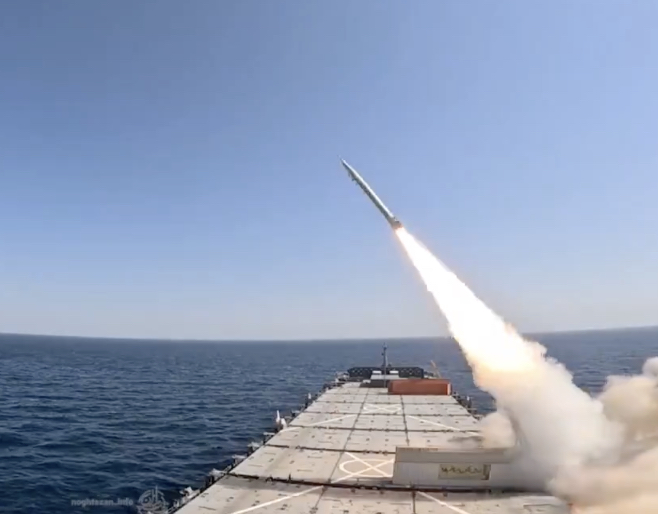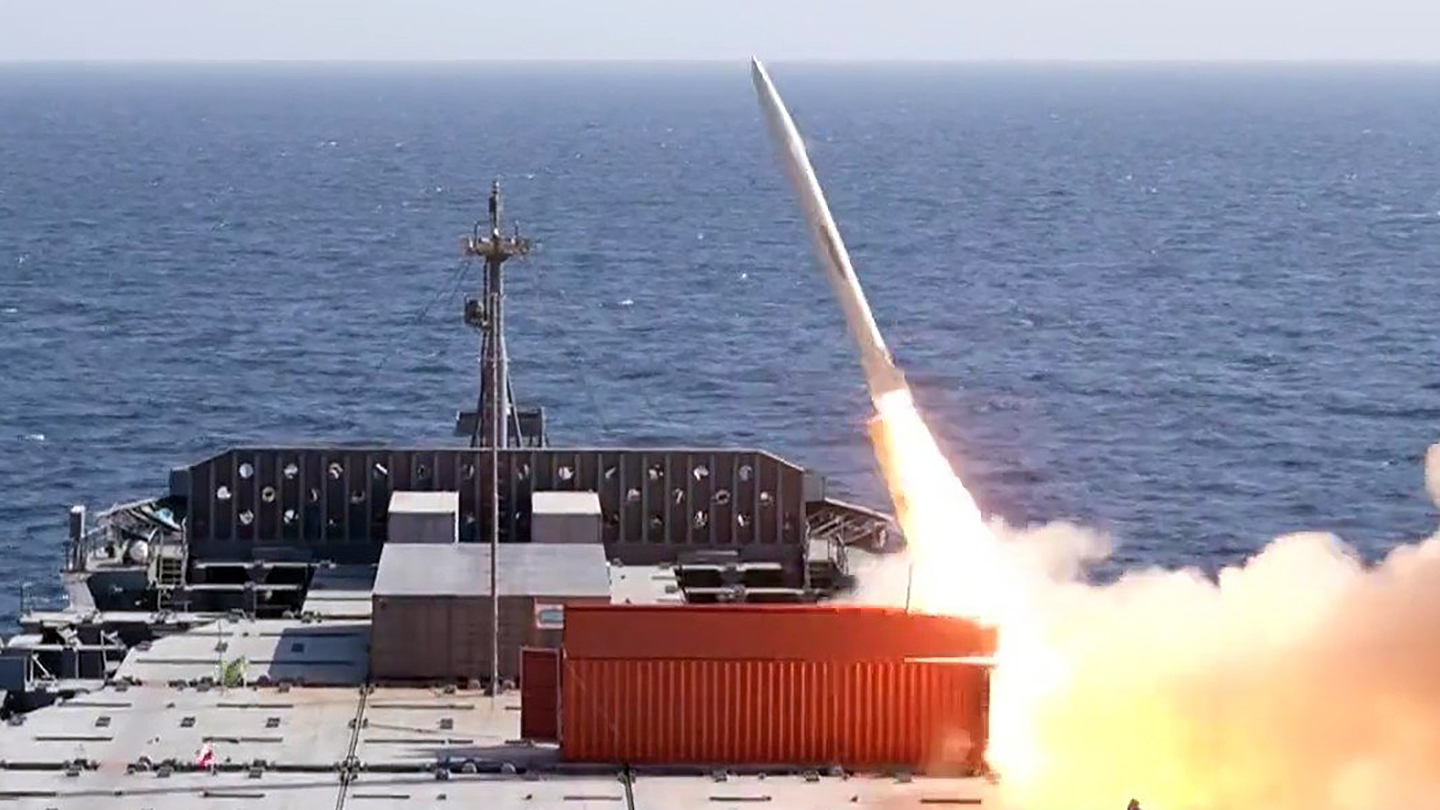Iran’s Islamic Revolution Guards Corps (IRGC) has fired two ballistic missiles from launchers disguised as standard shipping containers that were hosted aboard one of its sea base-like vessels. This particular combination, which has not been seen to date, greatly expands the reach with which those weapons could be used to strike potential targets by surprise, especially given that shipping containers can be embarked on any vessel that has the space to accommodate them.
The country’s IRGC-linked Tasnim News Agency reports that two “Fateh class” ballistic missiles were recently launched from Shahid Mahdavi, which the Iranian Navy took delivery of in March 2023 after it was converted from a state-owned and operated container ship known as the Sarvin. The outlet also notes that the launch was a collaboration between the IRGC’s naval and aerospace forces. At least one of the missiles went on to successfully hit their target in the central desert of Iran, it has been reported. The exact date on which this all occurred, which precise Fateh variant the missiles were, and the distance said missiles traversed to get to their targets, remains unclear at present.
Footage originally released by the Tasnim News Agency, linked below, shows two missiles firing from launchers housed within two separate shipping containers aboard the vessel. In it, we see the launches from various angles, thanks to the placement of video cameras around the ship and what appears to be drone footage captured from above. It also shows the supposed resulting impact on a target of one of the missiles, causing a large explosion.
Additional video released by the Islamic Republic News Agency (IRNA) also shows the launches from other perspectives, as well as what appears to be footage from the control operator’s position inside the ship.
Hard details on when exactly this took place are difficult to ascertain. Open-source intelligence (OSINT) accounts on Twitter/X have pointed to various possible dates. @M51_4ever, for example, notes that a peculiar 480 kilometer (298 mile) long Notice to Air Missions (NOTAM) was in place on February 12, which may have been connected to the launches, but highlights they could also have taken place earlier in January.
However, TankerTrackers suggests that the open water seen in the footage puts the launch date somewhere between January 25-27.
There seems to be greater agreement on the location from which the missiles were fired from Shahid Mahdavi, however, with the accounts putting the vessel between the cities of Jask and Chabahar along the Iranian coastline in the Gulf of Oman.

Which missile types were launched precisely also remains unclear. The Tasnim News Agency notes that the “Fateh class” missiles featured a 1,700 kilometer (1,056 mile) range. This is considerably longer than the Kheiber Shekan medium-range ballistic missile (MRBM); a third-generation Fateh ballistic missile with the longest known operational range within that family at 1,450 kilometers (900 miles).
However, other Iranian news agencies have suggested the range of the missiles was over 750 kilometers (466 miles), indicating they could have been Dezful MRBMs, which have a known range of over 1,000 kilometers (620 miles).
It has also been suggested the missiles could have been Zolfaghar short-range ballistic missiles (SRBMs), which have a known range of 700 kilometers (434 miles). Zolfaghar SRBMs are an improved version of Fateh 110, which has an operational range of 200-300 kilometers (124-186 miles).
Of course, the concept of using launchers disguised as shipping containers to both transport and deploy various kinds of missiles is well established. Years ago, Russia moved to disguise various cruise missile launching systems inside shipping containers and marketed the systems for sale.

Modular container-based launchers have since become more widespread. For instance, the U.S. has fielded a container launcher for Tomahawk and SM-6 missiles that works both at sea and on land. Many more types of far less capable systems now leverage containers as hosts. While some applications use containers for cost and logistical advantages, others really go the extra mile to disguise them to look as much like standard shipping containers as possible. Clearly, this is problematic when it comes to knowing where weapon systems are and are not, especially ones capable of long-range strikes.
Iranian proxies, such as militia groups in Iraq, have begun to use simpler short-range ballistic missiles fired from containers that are meant for concealment prior to launch. This is a relatively new capability, but it isn’t as polished as what we are seeing here nor is it paired with the latest in Iranian missile technology. Those systems have also not been deployed to sea.
What’s new here is firing ballistic missiles from a launcher that is well disguised as a standard shipping container aboard a ship. This has major potential consequences in the case of Iran and affiliated actors having access to this capability. It severely complicates the tracking of potential threats; gives the enemy a greater advantage in terms of the element of surprise; allows for weapons to be positioned far forward from where they could be otherwise without being detected; and basically makes every ship that can carry a container a potential hostile threat. Using ships as launch platform delivery systems means targets far away that were previously very challenging to put at risk now can be with the help of many kinds of vessels, and all without the advent of new longer-range weaponry.

While all this was already a growing concern for cruise missiles, the introduction of ballistic missiles with a similar launch concept adds additional challenges. Ballistic missiles are tough to defend against, especially across a wide area, and they arrive on target far faster, leaving less time to react. They also hit much harder than their air-breathing counterparts. All these factors, among others, make them especially threatening.
Just having a modular ballistic missile launch system that can be put on virtually any ship with enough room, regardless of whether it is disguised or not, is a big advantage for Iran.
This was highlighted by IRGC Commander Major General Hossein Salami, the Tasnim News Agency reports:
“Our ocean-going warships can be present in every location across the world, and when we can fire missiles from them, there is accordingly no safe spot for a power intending to create insecurity for us,” he said.

This remains particularly concerning given Iran’s use of ballistic missiles on neighboring countries in recent weeks. Tehran has used ballistic missiles to hit targets in Syria, Iraq, and Pakistan. While these may not have been directly related to the Israeli-Hamas conflict, they have no doubt sent a clear message to both the U.S. and Israel about Iran’s willingness to use its huge arsenal of ballistic missiles and the expanding reach and accuracy of that arsenal.
Of course, this test also comes amid a surge in discussions surrounding the threats from ballistic missiles thanks to the actions of Iranian-backed Houthi rebels. The militant group that controls a large part of Yemen became the first in the world to fire anti-ship ballistic missiles (ASBM) in anger, a threat that has been a hot topic of discussion for some time. The Houthis’ various attacks on commercial shipping and warships in the Red Sea using anti-ship ballistic missiles owe much to Iran; which has supplied it with these weapons, as well as components to construct them. You can read more about all that in this past War Zone feature.
One could imagine how non-state actors that serve as proxies for Iran could use this ship-borne, very low-profile capability for asymmetric attacks potentially far from the territory they inhabit, too.
We are sure to see much more of this capability in the future as Iran continues to rapidly evolve its arsenal and distribute parts of it to allied groups throughout the Middle East.
Tyler Rogoway and Joseph Trevithick contributed to this article.
Contact the author: oliver@thewarzone.com
